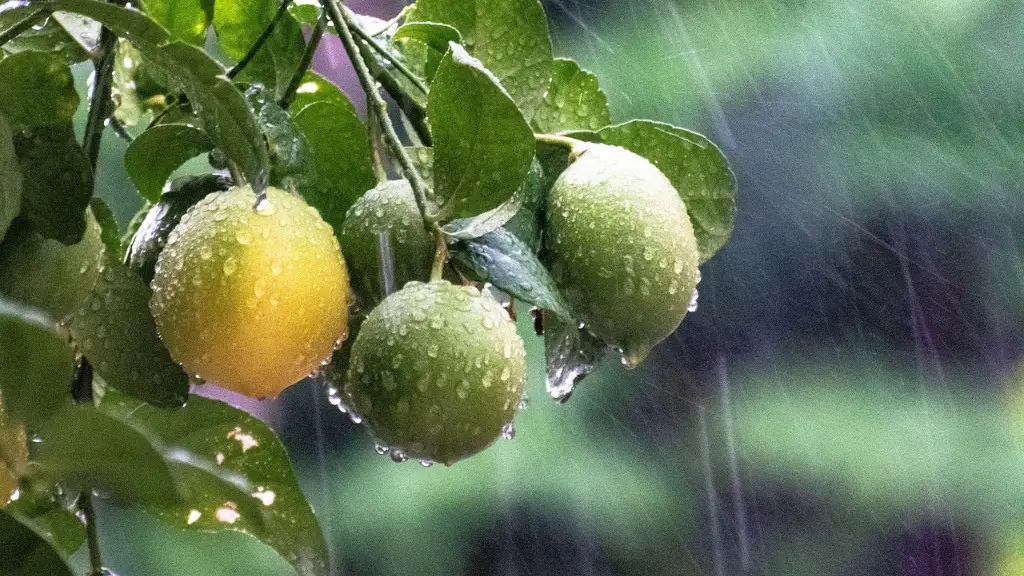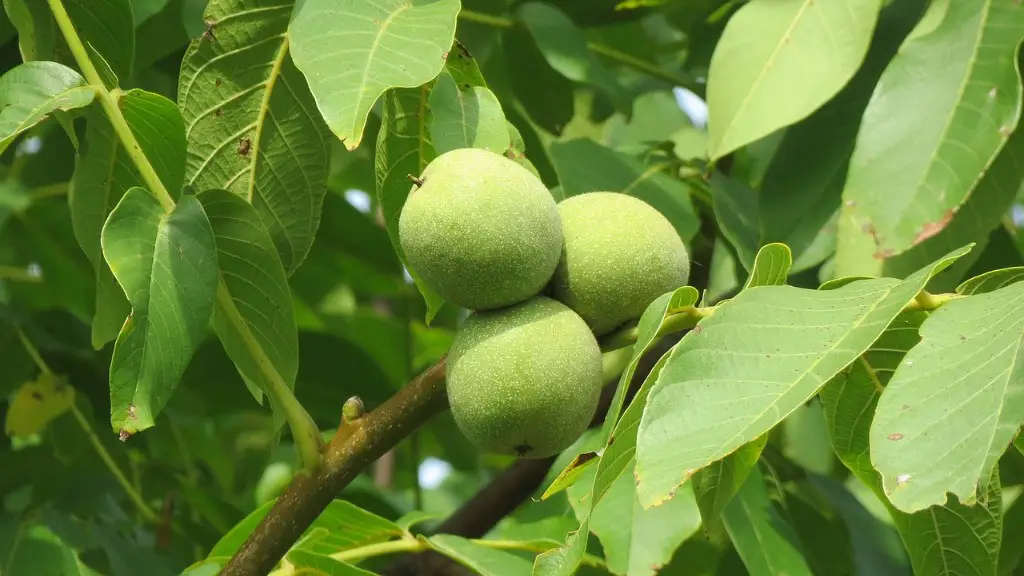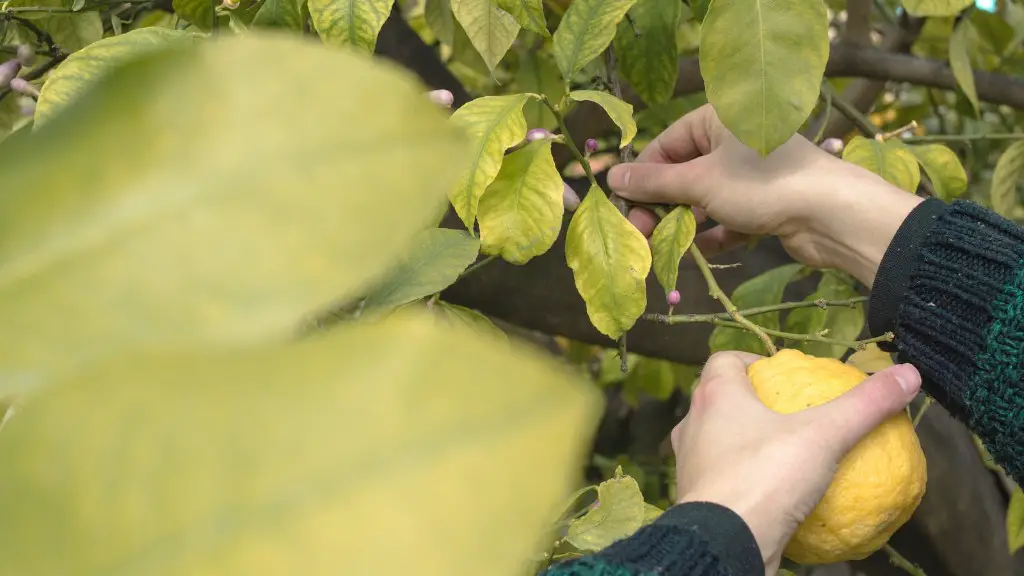When a lemon tree drops fruit it is important to determine the cause of the dropping before any corrective action can be taken. There are various possible causes for the phenomenon and some of them can be mitigated with good tree care. Firstly, lemon trees may suffer from nutrient deficiency, which is caused by an imbalance in the soil’s pH level, nutrient levels and water supply. Secondly, damage from pests, such as citrus scales and spider mites, or disease, such as citrus canker or root rot, can impair the tree’s ability to carry fruit and lead to its dropping prematurely. Thirdly, lemon tree fruit dropping can also be caused by improper pruning or training, too much or too little irrigation, and sudden changes in temperature, humidity or light.
In order to prevent the premature dropping of lemon tree fruit, it is important to first assess the tree’s overall health and environment. A soil test should be conducted to evaluate the soil’s pH, nutrient and water content, and any pests or diseased branches should be identified and treated as needed. Pruning and training should also be properly carried out, adequate irrigation should be supplied and sudden changes in the environmental conditions should be avoided.
Once the current tree health is stabilized, preventive measures can be taken for long-term protection against lemon tree fruitdropping. A fertilizing schedule should be developed, using the soil test results, to ensure the tree is supplied with the required nutrients for optimal growth. Further, monitoring of the tree for signs of pests, diseases and any other problems should be conducted on a regular basis, and appropriate pest control methods should be used to reduce their impact. Finally, attention should be paid to environmental factors such as temperature, humidity or light, and efforts should be made to keep these constants to prevent the sudden changes that lead to fruit dropping.
Nutrient Deficiency
Nutrient deficiency is one of the most common causes of lemon tree dropping fruit. A soil test should be conducted to inspect the pH level, nutrient levels, and water content of the soil, as any imbalances will prevent optimal nutrient uptake. Fertilization should be performed to correct the nutrient deficiency, using fertilizers rich in nitrogen, phosphorus, and potash. Mulching should also be done to help protect the tree’s root system, preserve moisture, and maintain proper soil pH.
Lemon trees should be irrigated regularly to meet their water needs. Over irrigation, however, can cause waterlogging, which in turn leads to reduced oxygen levels in the soil, stunted root growth and eventually fruit dropping. In areas of frequent rainfall or high humidity, this can be avoided by installing perforated canopies or drip irrigation systems. In regions where rainfall is scarce, irrigation via sprinklers or water cans is necessary to ensure sufficient water for the tree.
It is also important to control weeds that compete with the tree for nutrients and water. Pre-emergent herbicides should be used to prevent weed seeds from germinating, and hand-weeding should be regularly carried out if the tree is planted in a vegetable garden. Finally, application of fertilizer and compost can improve the soil fertility and thus nurture better health and growth of the lemon tree.
Pest and Disease Control
Inspecting for pests and diseases is also necessary for maintaining lemon tree health. The most common citrus pests in tropical and subtropical climates are citrus mealybugs and scale insects, while citrus rust mites, spider mites and whiteflies also occur in milder climates. All of these organisms feed on the tree’s nutrients, which can affect growth and fruit production. Insecticides should be used to control the pests and organic treatments, such as predatory mites and neem oil, are also effective if the infestation is not severe.
Various diseases can also affect lemon trees and cause the fruit to drop. The most common of these are citrus canker, caused by bacteria, and Huanglongbing (HLB), commonly known as citrus greening, caused by a phloem-limited bacterium. These diseases affect the entire tree and can lead to serious reduction in yield. Early detection is key for establishing effective control measures and the use of insecticides, fungicides and bactericides is recommended for treating the affected areas.
Other preventive measures for disease control include the proper pruning and training of the tree, switching to a compatible rootstock, and appropriate irrigation. The affected parts of the tree should be removed, avoiding infection of the other parts. Moreover, good aeration and drainage are important for reducing the chances of disease or pest infestation and should be maintained when planting and keeping the tree.
Environmental Factors
Temperature, humidity and light levels also impact a lemon tree’s health and fruit production. Temperatures below 20°C can cause flowers and fruit to drop, while temperatures above 30°C can cause flowers to abort. Too much humidity can cause fungus to grow and too little can cause the tree to absorb water more slowly, resulting in reduced leaf growth and fruit yield. Exposure to direct sunlight can cause sunburn, while lack of light can lead to the tree’s abscission.
To mitigate the negative effects of environmental conditions, shading should be provided in times of intense heat and direct sunlight. Further, extra humidity can be added in dry climates by installation of a humidifier or through ground irrigation. Additionally, using reflective materials can reduce the heat accumulation near the tree and provide enough ambient light for proper photosynthesis.
Finally, wind protection measures can help reduce the physical damage caused by wind. For example, a wind shield can be installed around the tree and hedges can be planted near the tree. However, care should be taken to avoid creating too much wind protection that can lead to humidity build-up, which in turn may lead to pest infestations.
Rootstock Selection
The choice of rootstock can affect the health and yield of the lemon tree. Some rootstocks are less tolerant to drought and disease or cannot support heavy loads of fruit, which can cause premature fruit dropping. It is important to select rootstock that is adapted to the climate, soil and water conditions of the area, and is self-fertile and vigorous, and also resistant to diseases. Lemon tree cultivars grafted on sour orange rootstock are recommended for hot, humid climates, while cultivars grafted on rough lemon rootstock are suited for cooler, drier climates.
Citrus trees in general should be planted in summer because they grow better in warm climates and soil. Planting should be done in the late afternoon to limit the exposure to direct sunlight. As lemon trees will be bearing fruit in just a few months, proper fertilizing and irrigation must be done to ensure a good crop.
The tree should be pruned regularly to remove dead wood and diseased branches, maintain a desired shape and encourage fruit production. Proper pruning and training are important to prevent the limbs from becoming too heavy due to abundant fruit production, which can cause them to break off and fruit to prematurely drop.
Fruit Maturity and Harvesting
In most cases, fruit dropping is due to low maturity of the fruit. Lemons should be left to ripen on the tree for at least 2 weeks for most cultivars though some may take as long as 4 weeks. When the fruit changes from green to yellow, it is generally considered ripe enough for harvesting.
To reduce damage of the fruit during harvest, it is important to use the right tools. Clipper pruners are the best tools for harvesting fruit as they are designed to produce a clean cut and cause less damage to the fruit. Gently twisting the fruit off the tree is recommended; pulling the fruit off may cause damage to the fruit or the tree.
Fruit that has been harvested should be used, processed or sold quickly. If not, the fruits should be stored in a dry and cool place. The storage life of lemon fruits can be extended by applying wax coating or covering the fruit with a plastic wrap to prevent dehydration.
Disease Prevention
Preventing disease is an important factor in maintaining healthy lemon trees. Proper sanitation should be used to prevent introduction and spread of pathogens; tools and equipment should be disinfected regularly. Insecticides should be used to control any pests, and fungal pathogens should be controlled with fungicides. Moreover, copper and sulfur-based fungicides can be used to fight off bacterial and fungal diseases, respectively.
In areas where pests and diseases are severe, it is recommended to protect the tree with a protective wrap or net to limit the contact with the pests or diseases. It is also important to observe proper timing when introducing any new trees or plant material into the garden, as any infected material can lead to contamination of the other plants.
Planting resistant or tolerant varieties of lemon trees is also recommended, as their rootstock and leaves are less likely to get infected by pathogens, and the chances of fruit dropping due to infection is reduced. Additionally, using sterile soil, buying trees from certified nurseries, and pruning the trees properly for effective air circulation can also help in preventing disease infection.
Conclusion
Lemon tree fruit dropping can be attributed to many factors, such as nutrient deficiency, pests, diseases and environmental conditions. In order to reduce the chances of premature fruit dropping, it is important to assess the tree’s overall health and environment, take preventive measures and perform regular controls. Furthermore, careful selection of rootstock and proper pruning and training are recommended to maintain the tree’s vigor and extend the yield. Last but not least, disease prevention is essential for keeping the tree healthy and providing a steady yield over time.



